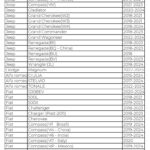The OBD-II (On-Board Diagnostics, second generation) connector, standardized by SAE J1962, is the gateway to a vehicle’s diagnostic data. Understanding the Obd Connector Pinout is crucial for mechanics, technicians, and car enthusiasts alike. This guide provides a detailed breakdown of the pin assignments for various OBD-II connector types.
OBD-II Connector Types and Pinouts
There are several types of OBD-II connectors, but Type A and Type B are the most common. Type A connectors are typically found in 12V systems, while Type B connectors are used in 24V systems, primarily in heavy-duty vehicles.
Type A Connector (12V)
This image illustrates the female, 16-pin configuration of the Type A OBD-II connector. Each pin has a specific function, detailed in the table below:
| Pin Number | Description |
|---|---|
| 1 | Manufacturer Discretionary |
| 2 | SAE J1850 Bus + (VPW / PWM) |
| 3 | Manufacturer Discretionary |
| 4 | Chassis Ground |
| 5 | Signal Ground |
| 6 | CAN High (ISO 15765-4 and SAE J2284) |
| 7 | ISO 9141-2 / ISO 14230-4 K Line |
| 8 | Manufacturer Discretionary |
| 9 | Manufacturer Discretionary |
| 10 | SAE J1850 Bus – (PWM-only) |
| 11 | Manufacturer Discretionary |
| 12 | Manufacturer Discretionary |
| 13 | Manufacturer Discretionary |
| 14 | CAN Low (ISO 15765-4 and SAE J2284) |
| 15 | ISO 9141-2 / ISO 14230-4 L Line (Optional) |
| 16 | Vehicle Battery Power: 12V/4A |
Type B Connector (24V)
This image shows the female, 16-pin layout of the less common Type B connector, used for 24V systems. While visually similar to Type A, some pin functions can differ.
Pin assignments for the Type B connector are generally the same as Type A, with the key difference being the voltage on pin 16:
| Pin Number | Description |
|---|---|
| 16 | Vehicle Battery Power: 24V/2A |
Standardized and Manufacturer-Specific Pins
The OBD-II standard defines specific functions for certain pins, ensuring compatibility across different vehicle makes and models. These standardized pins allow generic OBD-II scanners to retrieve basic diagnostic information like engine RPM, speed, and fault codes. However, some pins are left to the manufacturer’s discretion, allowing them to implement custom communication protocols or provide access to vehicle-specific data. These manufacturer-specific pins often require specialized scan tools for proper interpretation. Examples of common standardized communication protocols utilizing the OBD connector pinout include CAN (Controller Area Network), J1850 (primarily used by Ford and GM), and ISO 9141-2/14230-4 (commonly found in European and Asian vehicles).
Understanding OBD Protocols and Pin Usage
Different communication protocols utilize various pins on the OBD-II connector. For instance, CAN communication uses pins 6 (CAN High) and 14 (CAN Low), while J1850 protocols utilize pins 2 and 10. Understanding these protocol-specific pin assignments is essential for troubleshooting communication issues and selecting the appropriate diagnostic tools.
Conclusion
Knowing the OBD connector pinout is essential for anyone working with vehicle diagnostics. Whether you’re a professional technician or a DIY enthusiast, this knowledge empowers you to interpret diagnostic data, troubleshoot problems, and gain a deeper understanding of your vehicle’s systems. By referencing this guide, you can effectively utilize the OBD-II connector for various diagnostic and maintenance tasks.
